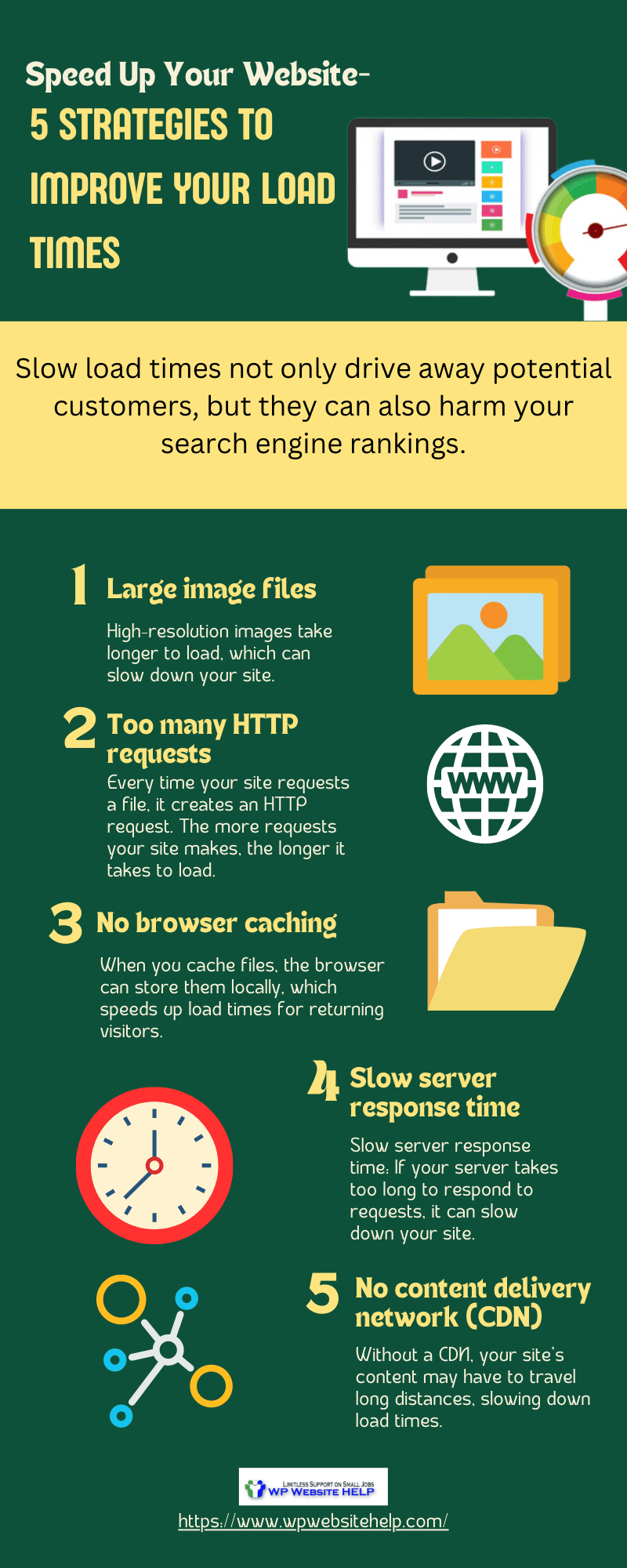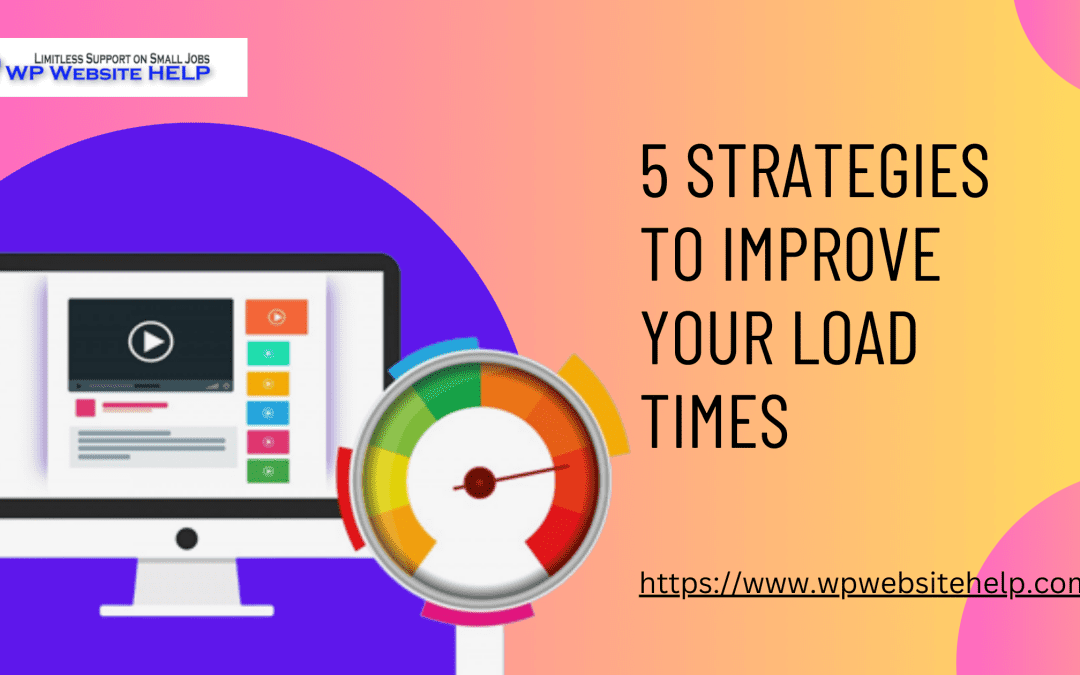In today’s fast-paced world, having a slow-loading website can be a death sentence for your online business. Slow load times not only drive away potential customers, but they can also harm your search engine rankings.
So, if you want your website to be successful, you need to make sure it loads quickly.
In this article, we’ll show you 5 strategies to improve your load times and keep your visitors happy.
What Causes Slow Site Speed?
Before we dive into the strategies to speed up your website, let’s first understand the causes of slow site speed.
There are several factors that can affect your site’s load times, including:
- Large image files
- Too many HTTP requests
- No browser caching
- Slow server response time
- No content delivery network (CDN)
Large images: High-resolution images take longer to load, which can slow down your site.
Too many HTTP requests: Every time your site requests a file, it creates an HTTP request. The more requests your site makes, the longer it takes to load.
No browser caching: When you cache files, the browser can store them locally, which speeds up load times for returning visitors.
Slow server response time: If your server takes too long to respond to requests, it can slow down your site.
Lack of a content delivery network (CDN): Without a CDN, your site’s content may have to travel long distances, slowing down load times.
What to Do about Website Slow Loading Speed
Now that you understand the causes of slow site speed, let’s discuss five strategies to improve your website’s load times.
Hope you’ve got your jotter? Let’s roll!
1#. Optimize Your Images
As we mentioned earlier, large images can slow down your site. To optimize your images, consider the following:
- Use the right format: JPEG is best for photographs, while PNG is best for graphics.
- Resize your images: Resize your images to the correct dimensions before uploading them to your site.
- Compress your images: Use an image compression tool to compress your images without losing quality.
By optimizing your images, you can significantly reduce load times and improve site speed.
2#. Minimize HTTP Requests
Each time your site requests a file, it creates an HTTP request. The more requests your site makes, the longer it takes to load. To minimize HTTP requests, consider the following:
- Combine files: Combine multiple CSS and JavaScript files into one file to reduce HTTP requests.
- Minify files: Minify your HTML, CSS, and JavaScript files to reduce their file size and improve load times.
- Use a content delivery network (CDN): A CDN can reduce the number of HTTP requests by caching files on servers located closer to your site visitors.
By minimizing HTTP requests, you can reduce load times and improve site speed.
3#. Utilize Browser Caching
When you cache files, the browser can store them locally, which speeds up load times for returning visitors. To utilize browser caching, consider the following:
- Set expiration dates: Set expiration dates for your files to ensure that the browser knows when to fetch new files.
- Enable gzip compression: Enable gzip compression to compress your files and reduce their file size.
- Use a content delivery network (CDN): A CDN can cache files on servers located closer to your site visitors, reducing load times for returning visitors.
By utilizing browser caching, you can significantly improve load times for returning visitors and improve site speed.
4#. Reduce Server Response Time
If your server takes too long to respond to requests, it can slow down your site. To reduce server response time, consider the following:
- Use a reliable web host: Choose a reliable web host that can handle your site’s traffic and respond quickly to requests.
- Enable caching: Enable server-side caching to speed up responses to frequently requested files.
- Use a content delivery network (CDN): A CDN can reduce the distance between your site visitors and your server, improving response times.
By reducing server response time, you can significantly improve load times and site speed.
5#.Use a Content Delivery Network (CDN)
Without a CDN, your site’s content may have to travel long distances, slowing down load times. A CDN is a network of servers that can cache your site’s content and serve it to your visitors from the server closest to them. To use a CDN, consider the following:
- Choose a reliable CDN provider: Choose a reliable CDN provider that can handle your site’s traffic and provide fast delivery.
- Enable CDN caching: Enable caching on your CDN to ensure that your site’s content is served quickly to your visitors.
By using a CDN, you can significantly reduce load times and improve site speed for your visitors.
5 ways To Fix Your Slow-Loading Website Click To TweetPoints Extra
Reduce Server Response Time
To improve server response time, website owners can fine-tune website code and database queries, use content delivery networks (CDNs), and upgrade to high-performance hosting plans. A speedy response from the server can significantly reduce website loading time and enhance user satisfaction.
Implement Lazy Loading
This technique allows images and other media content to load as the user scrolls down the page instead of loading everything at once. This approach can significantly reduce the initial loading time, resulting in a faster page-loading experience.
Compress and Gzip Your Website
Gzip is a popular compression algorithm that can be used to compress your website’s files before they are transmitted to the user’s device. Most web servers support Gzip compression, and it’s easy to enable. By compressing and Gzipping your website, you can speed up load times and improve overall user satisfaction.

FAQs
You can test your site’s speed using various online tools, such as Google PageSpeed Insights, GTmetrix, and Pingdom. These tools can provide insights into your site’s performance and suggest improvements to speed up your site.
It’s best to optimize your site’s images before uploading them to your site. However, if you’ve already uploaded images and noticed slow load times, you can use an image compression tool to compress your existing images.
No, you don’t need to be a technical expert to implement these strategies. Most website builders and content management systems (CMS) have built-in features to optimize images, minimize HTTP requests, and enable browser caching. However, if you’re unsure how to implement these strategies, you can consult with a web developer or hire a professional to help.
It’s possible to use more than one CDN for your site, but it’s not recommended. Using multiple CDNs can cause conflicts and slow down your site’s load times. It’s best to choose a reliable CDN provider and optimize its caching settings for your site.
Conclusion
Improving your website’s load times is essential for improving user experience and search engine rankings. By optimizing your images, minimizing HTTP requests, utilizing browser caching, reducing server response time, and using a content delivery network (CDN), you can significantly improve your site’s speed. Remember to test your site’s speed regularly and implement these strategies to provide your visitors with the best possible experience.
Read Also: 10 Ways to Speed up WordPress site
We are dedicated to sharing useful content for WordPress websites in the business & personal communities. This includes any related topics indirectly related to WordPress, marketing, advertising, e-commerce, technology, or any other online subjects we feel would benefit our readers and customers.
Debashrita @ The WP Website Help Team

